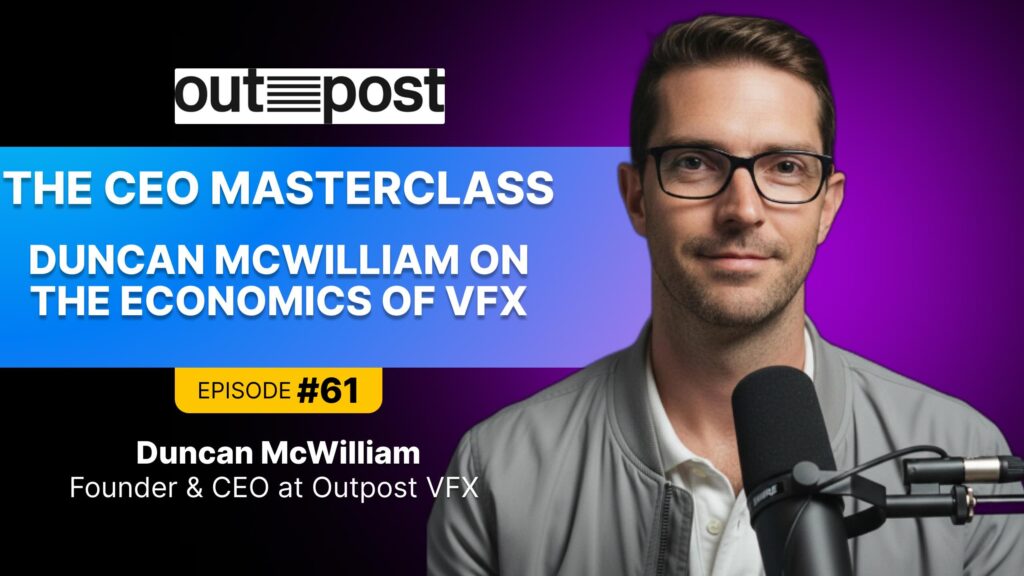Welcome to the Vitrina Podcast, where we dive into the most innovative and cutting-edge companies from within the global entertainment supply chain.
In this fourth episode of Vitrina Podcast, we welcome Chris Ledoux, Co-Founder & Chairman at Crafty Apes.
TV was a way better place to be, because of the way the deals were structured…
Podcast Chapters
| 01:06 | Chris’s Journey in VFX |
| 01:56 | Impact of COVID-19 on the Industry |
| 04:48 | The Rise of Streaming and Global Markets |
| 08:07 | The Impact of Cable Television on Storytelling |
| 15:26 | The Transformation of VFX |
| 20:18 | The Story of Crafty Apes |
| 31:35:00 | The Story of Luma Logic |
| 47:15:00 | AI’s Impact on the Film Industry |
| 48:28:00 | The Impact of AI on VFX |
| 56:28:00 | The Role of AI in the Supply Chain |
| 01:10:58 | Outlook for 2024 |
| 01:12:56 | Streaming Platforms and Content Production |
| 01:13:14 | The Decline of Theaters and the Rise of Streaming |
| 01:18:00 | Revival of IP Optioning |
| 01:18:18 | Closing Remarks and Optimism for the Future |
Ultimately, what I observed was — can you think of any other industry where someone spends a $100 million and doesn’t know what they’re getting…
Dive into the dynamic world of filmmaking and entertainment while exploring the industry shifts, personal stories, and technological advancements with Chris Ledoux, unveiling the intricate tapestry of creativity, business dynamics, and the evolving landscape of visual storytelling.
From the impact of COVID-19 to the rise of streaming, AI’s influence, and the future outlook, each chapter paints a vivid picture of the entertainment realm. Join us as we unravel the stories behind Crafty Apes, Luma Logic, and more, culminating in a comprehensive exploration of the current state and future possibilities within the film and entertainment industry.
Alaskan-born Chris LeDoux, a VFX luminary and director, embarked on a remarkable journey from compositor to high-level VFX supervisor. Renowned for managing intricate projects, his expertise spans AI, ML, and computer vision, redefining narrative filmmaking. LeDoux’s impactful contributions include collaborations on Hidden Figures and La La Land, showcasing his pioneering role in the industry. Based in Atlanta, he adeptly balances professional and personal life, leaving an indelible mark on the VFX landscape.
About Crafty Apes:
Crafty Apes, a global VFX company founded by industry veterans Chris LeDoux, Tim LeDoux, and Jason Sanford, boasts offices worldwide with over 550 talented artists. Celebrating a decade, it provides comprehensive VFX services for blockbusters like The Batman and series like Stranger Things, blending creativity with AI and machine learning expertise.
Crafty Apes' Latest Work







Why You Should Connect With Crafty Apes?
- Top-Notch Visual Effects Expertise: Crafty Apes, with AAA+ reputation, offers unparalleled visual effects (VFX) services, specializing in on-set supervision, CGI, and 3D animations, ensuring top-tier quality for projects.
- Proven Track Record: Boasting an impressive portfolio, including collaborations with major streaming platforms like Netflix, Apple TV+, Disney+, Hulu, and Paramount+, Crafty Apes has delivered exceptional VFX for renowned TV series and movies.
- Comprehensive Post-Production Services: As a full-service boutique, Crafty Apes provides end-to-end post-production solutions, from visual effects studios to color correction, catering to the diverse needs of the entertainment industry.
- Industry Recognition: With an overall rank of 84 and a high engagement level in post-production, Crafty Apes is recognized as a leading player in the industry, showcasing reliability and expertise.
- Experienced Leadership: Founded in 2011 by visual effects veterans Jason Sanford, Chris LeDoux, and Tim LeDoux, Crafty Apes emphasizes the importance of strong 2D compositing as the backbone of quality visual effects, ensuring seasoned leadership in every project.
Navigating Changes in Hollywood: A Conversation with Chris LeDoux
This is a written version of the Vitrina podcast featuring Chris LeDoux, co-founder of Crafty Apes and founder of Luma Logic. This Q&A-style transcript is tailored for quick reading, offering insights into VFX, industry changes, and expectations for the future in Hollywood.
1. Vitrina: Chris, can you give us a brief introduction about yourself and Luma Logic?
Chris LeDoux: Absolutely, I’m glad to be here. While I am not the founder of the well-known VFX company Luma, I established Luma Logic, which is distinct and not a VFX company. My career has primarily revolved around leveraging technology to enhance visual effects and production workflows, which significantly impacts how productions manage their visual assets. Luma Logic is more focused on integrating cutting-edge technologies like AI to streamline production processes rather than creating visual effects directly.
2. Vitrina: How did the VFX industry cope with the challenges brought by the COVID-19 pandemic?
Chris LeDoux: The pandemic brought unprecedented challenges to the VFX industry, initially causing a significant slowdown as productions halted globally. However, the VFX sector demonstrated remarkable resilience by adapting quickly to remote work setups, which were somewhat easier to implement due to the digital nature of the work. Despite these adaptations, the rush to resume productions led to a ‘regression to the mean’ where the quality and quantity of output tried to normalize but were met with complications from fluctuating project financing and logistical challenges due to intermittent lockdowns.
3. Vitrina: What are your projections for the theatrical production levels returning to their pre-2019 standards?
Chris LeDoux: It’s a complex forecast. Many industry analysts, myself included, don’t see theatrical production volumes returning to pre-pandemic levels until at least 2026. This projection isn’t just about overcoming current challenges but also about the industry adjusting to new consumer behaviors, such as increased streaming service consumption. The timeline could accelerate with favorable economic conditions, like lower interest rates, which would enable easier financing for big-budget productions. However, the unpredictability of consumer preferences post-pandemic adds a layer of complexity to any predictions.
4. Vitrina: Considering global market dynamics, how is Hollywood adapting to maintain its competitive edge?
Chris LeDoux: Hollywood is increasingly looking to global markets to fuel its growth, acknowledging that the domestic box office alone cannot sustain its historical revenue streams. This strategy includes not only distributing American-made films globally but also producing content that resonates with international audiences, incorporating local languages, cultures, and themes. For instance, Netflix and other streaming platforms are investing heavily in local content for regions like India and South Korea, which have shown a robust appetite for native content that also appeals globally.
5. Vitrina: How do you balance the business and creative aspects of film production to maintain sustainability and profitability?
Chris LeDoux: Balancing the creative and business aspects of film production is increasingly challenging in an environment that demands both innovation and profitability. Successful projects often stem from a strong alignment between creative vision and business strategy. For example, Marvel Studios has mastered this balance by developing a creative universe that also serves as an interlinked franchise, driving merchandise, sequels, spin-offs, and streaming series. Each project is not just a film but part of a larger, highly strategic business model that maximizes audience engagement across multiple platforms.
6. Vitrina: How have streaming services influenced the industry’s approach to risk-taking compared to traditional broadcasters?
Chris LeDoux: Streaming services like Netflix, Amazon Prime Video, and Hulu have significantly altered the risk profile of content production by favoring data-driven decisions that allow for more targeted content development. These platforms use detailed viewer data to assess risk, enabling them to commission shows and films that traditional broadcasters might deem too niche or risky. This data-centric approach allows streaming services to experiment with diverse genres and unconventional storytelling, which has led to the success of groundbreaking shows like “Stranger Things” and “The Queen’s Gambit,” which might have struggled to find a home on traditional TV.
7. Vitrina: From your experience, what are the biggest changes that have recently transformed the VFX industry?
Chris LeDoux: The most significant transformation in the VFX industry is the integration of Artificial Intelligence. AI technologies are revolutionizing how visual effects are created, making processes faster and less costly while also opening up new creative possibilities. For example, AI-driven tools can now automatically generate complex environments or realistic crowd scenes that previously would have taken days or weeks to create manually. Additionally, machine learning models are being used to enhance the quality of effects, such as improving the realism of digital human characters and facial animations in movies.
8. Vitrina: Can you discuss the financial models that support modern film production and their impact on the types of projects that get greenlit?
Chris LeDoux: Modern film production is increasingly reliant on sophisticated financial models that assess potential return on investment, heavily influencing which projects get greenlit. Streaming services often use subscription data to predict demand for certain genres or themes, which can lead to safer, data-driven decision-making about what content to produce. For instance, a service might analyze viewing trends that favor dark comedies and decide to invest in similar projects. However, this model also risks homogenization of content, where unique, risky projects might struggle to receive funding unless they fit the predictive analytics mold.
9. Vitrina: What future trends do you foresee in content creation and distribution as technology, especially AI, continues to evolve?
Chris LeDoux: As AI continues to evolve, I anticipate a significant shift in both content creation and distribution. AI is expected to not only streamline content production through automation and enhanced creative tools but also revolutionize distribution by optimizing streaming algorithms to personalize viewer experiences more effectively. Furthermore, AI could lead to the development of interactive or customizable content where viewers could choose story outcomes or explore different story arcs, transforming passive viewing into an interactive experience.
10. Vitrina: Lastly, how do you envision the role of AI in the VFX sector changing in the next five years?
Chris LeDoux: Over the next five years, AI’s role in the VFX sector is set to become even more critical. We can expect AI to handle more complex and creative tasks, gradually shifting from assistance to leading roles in creating detailed textures, environments, and even autonomous character animations. This shift will likely lead to more cost-effective productions and potentially lower barriers to entry for smaller studios, democratizing high-quality VFX. Moreover, as AI tools become more accessible and integrated into standard VFX software, the speed and efficiency of VFX production will dramatically increase, enabling filmmakers to achieve previously unimaginable visual feats within tighter budgets and schedules.





